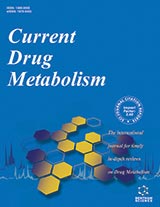摘要
以肉桂酸苄基酰胺(CABA)支架为基础的类似物表现出对肿瘤细胞的多效性,其作用的确切的分子机制正在研究当中。这里报道的是我们系统研究CABA类似物与其分子靶标的相互作用的一部分。这些化合物被证明能够抑制Janus激酶2(JAK2)/信号传导及转录活化因子3(STAT3)和JAK2/信号传导及转录活化因子5(STAT5)的激活信号,因而是有吸引力的抗癌药物设计的支架。为了证实这一类化合物的潜在作用机制,对选择的CABA类似物和JAK2激酶的直接相关作用进行了检测。对JAK2酶的活性的抑制进行了评估,对选择的化合物—(E)-2 - 氰基-N - [(S)-1 - 苯基乙基]-3 - (吡啶-2 - 基)丙烯酰胺(WP1065),(E)-2 - 氰基-N - [(S)-1 - 苯基丁基] - 3(3-溴吡啶-2 - 基)丙烯酰胺(WP1130),和(E)-2 - 氰基-N - [(S)-1,4 - 二苯基丁基]-3 - (3 - 溴吡啶-2 - 基)丙烯酰胺(WP1702) —在JAK2激酶结构域的分子建模研究用于支持实验数据的解读。我们的结果表明所测试的CABA类似物是非经典的JAK2激活(磷酸化的)的抑制剂,尽管其活性明显弱于临床测试的ATP-竞争性的JAK2抑制剂。但所研究化合物相对小的结构改变将影响其与JAK2的相互作用,他们的作用类型包括变构的非竞争性抑制到双底物竞争性抑制。这些结果表明,由WP1065 (半抑制浓度 [IC50] = 14.8 µM), WP1130 (IC50 = 3.8 µM), 和 WP1702 (IC50 = 2.9 µM)对JAK2酶活性的直接抑制作用虽然很弱,但能潜在作用于抑制癌细胞的JAK2/STAT信号通路,且额外特定的结构修饰可能增加对JAK2的抑制作用。
关键词: 双结构竞争性抑制,肉桂酸苄基酰胺,肉桂酸,抑制剂,Janus激酶2,分子建模,非竞争性抑制,信号传导及转录活化因子3,信号传导及转录活化因子5,WP1065
图形摘要
Current Cancer Drug Targets
Title:Analogs of Cinnamic Acid Benzyl Amide As Nonclassical Inhibitors of Activated JAK2 Kinase
Volume: 14 Issue: 7
Author(s): Marcin Mielecki, Małgorzata Milner-Krawczyk, Krystyna Grzelak, Damian Mielecki, Krystiana A. Krzysko, Bogdan Lesyng and Waldemar Priebe
Affiliation:
关键词: 双结构竞争性抑制,肉桂酸苄基酰胺,肉桂酸,抑制剂,Janus激酶2,分子建模,非竞争性抑制,信号传导及转录活化因子3,信号传导及转录活化因子5,WP1065
摘要: Scaffold-based analogs of cinnamic acid benzyl amide (CABA) exhibit pleiotropic effects in cancer cells, and their exact molecular mechanism of action is under investigation. The present study is part of our systemic analysis of interactions of CABA analogs with their molecular targets. These compounds were shown to inhibit Janus kinase 2 (JAK2)/signal transducer and activator of transcription 3 (STAT3) and JAK2/signal transducer and activator of transcription 5 (STAT5) signaling and thus are attractive scaffolds for anticancer drug design. To identify the potential mechanisms of action of this class of compounds, direct interactions of the selected CABA analogs with JAK2 kinase were examined. Inhibition of JAK2 enzymatic activity was assessed, and molecular modeling studies of selected compounds—(E)-2-cyano-N-[(S)-1-phenylethyl]-3-(pyridin-2-yl)acrylamide (WP1065), (E)-2-cyano-N-[(S)-1-phenylbutyl]- 3-(3-bromopyridin-2-yl)acrylamide (WP1130), and (E)-2-cyano-N-[(S)-1,4-diphenylbutyl]-3-(3-bromopyridin-2-yl)acrylamide (WP1702)—in the JAK2 kinase domain were used to support interpretation of the experimental data. Our results indicated that the tested CABA analogs are nonclassical inhibitors of activated (phosphorylated) JAK2, although markedly weaker than clinically tested ATP-competitive JAK2 inhibitors. Relatively small structural changes in the studied compounds affected interactions with JAK2, and their mode of action ranged from allosteric-noncompetitive to bisubstratecompetitive. These results demonstrated that direct inhibition of JAK2 enzymatic activity by the WP1065 (half-maximal inhibitory concentration [IC50] = 14.8 µM), WP1130 (IC50 = 3.8 µM), and WP1702 (IC50 = 2.9 µM) potentially contributes, albeit minimally, to suppression of the JAK2/STAT signaling pathways in cancer cells and that additional specific structural modifications may amplify JAK2-inhibitory effects.
Export Options
About this article
Cite this article as:
Mielecki Marcin, Milner-Krawczyk Małgorzata, Grzelak Krystyna, Mielecki Damian, Krzysko A. Krystiana, Lesyng Bogdan and Priebe Waldemar, Analogs of Cinnamic Acid Benzyl Amide As Nonclassical Inhibitors of Activated JAK2 Kinase, Current Cancer Drug Targets 2014; 14 (7) . https://dx.doi.org/10.2174/1568009614666140821122718
| DOI https://dx.doi.org/10.2174/1568009614666140821122718 |
Print ISSN 1568-0096 |
| Publisher Name Bentham Science Publisher |
Online ISSN 1873-5576 |
 35
35
- Author Guidelines
- Bentham Author Support Services (BASS)
- Graphical Abstracts
- Fabricating and Stating False Information
- Research Misconduct
- Post Publication Discussions and Corrections
- Publishing Ethics and Rectitude
- Increase Visibility of Your Article
- Archiving Policies
- Peer Review Workflow
- Order Your Article Before Print
- Promote Your Article
- Manuscript Transfer Facility
- Editorial Policies
- Allegations from Whistleblowers
Related Articles
-
Effect of Non-Ionizing Electromagnetic Fields of Anthropic Origin on Male Fertility
Current Chemical Biology Nanostructures for Drug Delivery to the Brain
Current Medicinal Chemistry Protein Pool Maintenance During Oxidative Stress
Current Pharmaceutical Design The miR-183/96/182 Cluster Regulates Oxidative Apoptosis and Sensitizes Cells to Chemotherapy in Gliomas
Current Cancer Drug Targets Specific Cytostatic and Cytotoxic Effect of Dihydrochelerythrine in Glioblastoma Cells: Role of NF-κB/β-catenin and STAT3/IL-6 Pathways
Anti-Cancer Agents in Medicinal Chemistry Better Targeting Melanoma: Options Beyond Surgery and Conventional Chemotherapy
Recent Patents on Endocrine, Metabolic & Immune Drug Discovery (Discontinued) Naturally-occurring Dimers of Flavonoids as Anticarcinogens
Anti-Cancer Agents in Medicinal Chemistry Progress in the Preclinical Discovery and Clinical Development of Class I and Dual Class I/IV Phosphoinositide 3-Kinase (PI3K) Inhibitors
Current Medicinal Chemistry How do Glial Cells Contribute to Motor Control?
Current Pharmaceutical Design Indoles and Related Compounds as Cannabinoid Ligands
Mini-Reviews in Medicinal Chemistry Cdc25A Protein Phosphatase: A Therapeutic Target for Liver Cancer Therapies
Anti-Cancer Agents in Medicinal Chemistry MDM2 Increases Drug Resistance in Cancer Cells by Inducing EMT Independent of p53
Current Medicinal Chemistry Nanofibers: New Insights for Drug Delivery and Tissue Engineering
Current Topics in Medicinal Chemistry Biological and Pharmacological Activities of Iridoids: Recent Developments
Mini-Reviews in Medicinal Chemistry MicroRNAs in the Intracellular Space, Regulation of Organelle Specific Pathways in Health and Disease
MicroRNA Structure, Function and Biological Relevance of Prolyl Oligopeptidase
Current Protein & Peptide Science Mechanisms of Oxidative Glutamate Toxicity: The Glutamate/Cystine Antiporter System xc¯ as a Neuroprotective Drug Target
CNS & Neurological Disorders - Drug Targets Targeted α-Particle Therapy: A Clinical Overview
Current Radiopharmaceuticals Pentacyclic Triterpenoids and Their Saponins with Apoptosis-Inducing Activity
Current Topics in Medicinal Chemistry Mutant Epidermal Growth Factor Receptors as Targets for Cancer Therapy
Current Cancer Drug Targets


























